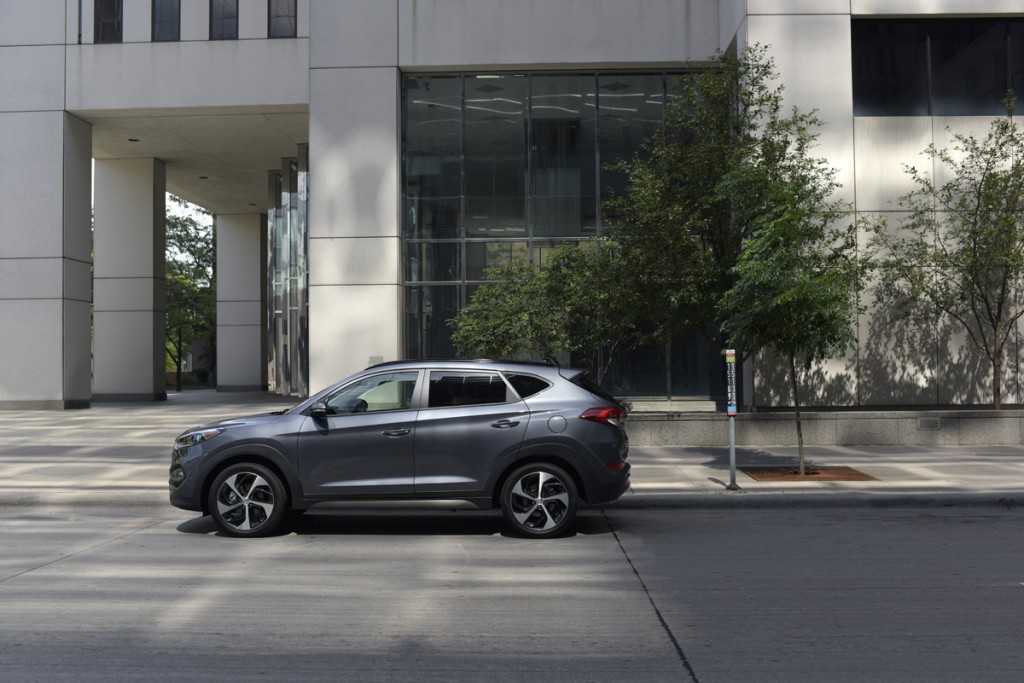The redesigned 2016 Hyundai Tucson lets its maker mount a new attack on the compact crossover utility segment, where it\’s lost market share even as sales have soared due to low gas prices and new, more fuel-efficient entries.
A tough competitive set includes popular rivals like the Honda CR-V, Toyota RAV4, and Ford Escape.
We recently drove the new Tucson on the highways and back roads of Minnesota and Wisconsin, where we were impressed by its stylish presence, refined road manners, and hush-quiet cabin.
DON\’T MISS: 2016 Hyundai Tucson – full review
The base SE gets a direct-injection 2.0-liter four-cylinder that makes 164 horsepower and 151 pound-feet of torque. It\’s mated to a traditional six-speed automatic transmission with regular, eco, and sport modes.
A turbocharged 1.6-liter four-cylinder producing 175 horsepower and 195 pound-feet of torque powers the other three trim levels — Eco, Sport, and Limited — through a seven-speed dual-clutch transmission that also features a trio of modes.

2016 Hyundai Tucson
Fuel economy has generally improved over the last Tucson. With front-wheel drive, the normally aspirated 2.0-liter SE is rated at 26 mpg combined (23 mpg city, 31 mpg highway). The turbocharged 1.6-liter Sport and Limited have EPA estimates of 27 mpg combined (25 mpg city, 30 mpg highway).
Despite sharing a drivetrain with the Sport and Limited, the Eco wrings out an estimated 29 mpg combined (26 mpg city, 33 mpg highway).
Hyundai attributes the difference to factors such as wheel size — like the SE, the Eco wears 17-inch wheels while the Sport and Limited have 19-inch variants.
ALSO SEE: Hyundai Tucson Fuel Cell: Early Drivers Discuss Experiences Traveling On Hydrogen
All of these fuel economy numbers take a hit when you add the $1,400 option of all-wheel drive. The loss is fairly slight with the turbo engine — 1 mpg city and 2 mpg highway — but a significant 2 mpg city and 5 mpg highway with the normally aspirated 2.0-liter engine.
The AWD system features a driver-selectable lock that splits torque between front and rear wheels, and also includes torque vectoring for enhanced cornering performance.
Not on the Tucson\’s U.S-market menu, at least for now, are two diesel-based concepts Hyundai unveiled at Geneva: a 48-volt mild hybrid and a plug-in hybrid.

2016 Hyundai Tucson
Nor has Hyundai said anything about a hydrogen-powered Tucson Fuel Cell in this new generation.
We spent most of our time in fully-optioned Limited models. We think the turbocharged 1.6 delivers adequate power in most circumstances, but hard acceleration reveals some hesitation before power kicks in. The DCT shifts nearly imperceptibly. Ride is smooth, handling is predictable, and steering is communicative.
Nothing about the Tucson encourages athletic driving — even 19-inch wheels that occasionally thump over highway joints — but most buyers will better appreciate the crossover\’s strong comfort-oriented attributes.

2016 Hyundai Tucson
Hyundai made a few SE models available for short drives — not enough for a comprehensive comparison of the two engines, but in low-speed stop-and-go city traffic, but power seemed more readily accessible from the SE\’s drivetrain, particularly in sport mode.
The new Tucson\’s exterior design gives it a premium look. Its familial hexagonal grille and geometric headlight assemblies sweep into a profile that creates a sporty sense of forward motion with a short greenhouse and dynamic wheel design.
From the rear, strong horizontal lines accentuate a pleasingly wide stance.

2016 Hyundai Tucson
Interior design is another Tucson strong suit, particularly in the top-spec Limited where soft-touch materials, a panoramic roof, and leather upholstery on comfortable, thickly bolstered seats lend an upscale feel.
There\’s plenty of room for four adults.
Room in a well-shaped cargo space grows to 30.1 cubic feet (seats up) and 61.0 cubic feet (seats folded) with the redesign, but this capacity still falls far short of that in key competitors.
MORE: 2016 Hyundai Tucson Hybrid Concepts in Geneva
The Tucson has a few tricks up its sleeve, though: a cargo floor that can be lowered by two inches, and an automatic liftgate on upper trim levels that activates when the key fob has been in close proximity for three seconds.
The SE shares its elegant dash and console design with the Limited — the touchscreen is 5 inches rather than 8 — but plenty of hard plastic trim diminishes the upmarket vibe you\’ll find in the Limited.
Tucson prices range from $22,700 to $31,300, exclusive of an $895 destination charge.
_________________________________________________
Follow GreenCarReports on Facebook, Twitter, and Google+.

